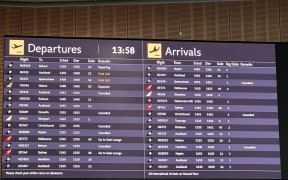
The number of migrants arriving in New Zealand over the past year was more than double those leaving, but both figures are provisionally the highest on record. Photo: RNZ / Marika Khabazi
Migrant arrivals and departures have hit record levels in the past year, but the monthly gain is slowing, latest figures show.
Stats NZ said there was a net gain of 5300 migrants in January - the lowest since October 2022.
The annual gain was nearly 134,000 compared to December's annual gain of 139,000.
The number arriving over the past year was more than double those leaving, but both figures were provisionally the highest on record.
The largest group of new migrants were Indian citizens, followed by citizens of the Philippines and China.
Many of the new migrants had filled gaps in the labour market, and others were overseas students.
Australia was the main destination for New Zealanders leaving, which included significant numbers of Chinese, Indian and British citizens.
The government has signalled aspects of its immigration policy are set for a reset and are actively under review.
'A bit of a double-edged sword'
Chief executive and principal economist at Infometrics Brad Olsen told Midday Report while the latest figures would be encouraging for the government, the monthly drop in migrant numbers was more likely to be a plateau as opposed to the beginning of a sharp drop.
"We think, looking through the numbers that we're probably seeing a plateauing of that higher net migration; we don't expect it to push a whole lot higher, but we're not quite so sure it's going to drop away quite as quickly as some people - including ourselves previously - might've hoped."
He said other recent Stats NZ figures had also provisionally shown increased departure numbers but those numbers had subsequently been revised lower, while incoming numbers had remained high.
The latest numbers were "just phenomenal", he said, both in terms of arrivals and departures.
"Population growth through 2023 added the equivalent of a whole new Dunedin city area. I mean, these are some pretty huge figures."
The high net migration was "a bit of a double-edged sword" when it came to its impact on the economy, he said.
Those arriving were being added to the workforce "but at the same time, those people also require services at a time when the economy is still stretched and inflation is still high".

Chief executive and principal economist at Infometrics Brad Olsen says the latest migrant arrival and departure statistics are "just phenomenal". Photo: RNZ / Samuel Rillstone
New migrants would be looking for work but high interest rates from the Reserve Bank had curbed spending activity by households, which in turn had led to businesses not needing to hire as many people, he said.
"In the December quarter alone, we saw an extra 15,000 people in the labour force in New Zealand; of those additional 15,000 people in the labour force, 12,000 people got jobs and around 3000 people didn't - so what we're seeing at the moment is that all parts of the economy are expanding: the labour force, the working-age population, the number of people in work - but also the number of people who aren't able to find a job."
Olsen said the increased numbers were also adding to pressure on existing rental housing stock - particularly in Auckland.
"If you look at rental growth in Auckland at the end of 2022, where net migration was starting to pick up a bit stronger, year-end growth in rents was about 2 percent; it accelerated to 6 percent at the end of last year. So you've seen that quite rapid increase with all of those ... additional people coming into New Zealand, they've gotta have a roof over their head, they've gotta find somewhere to live."
ASB senior economist Mark Smith said immigration was slowing.
"The net immigration outlook is dependent on a number of domestic and global factors and is highly uncertain. We nonetheless expect net PLT (permanent and long-term) inflows to cool over the next few years as the slowing economy reduces the attractiveness of New Zealand as a place to live and work."
He said it was also likely that some newly arrived immigrants would leave in a year or two.
The economic effect of the inflow has been an issue for the Reserve Bank in setting interest rates, but for the time being it has taken the view that record immigration has not been a major driver of inflation.






